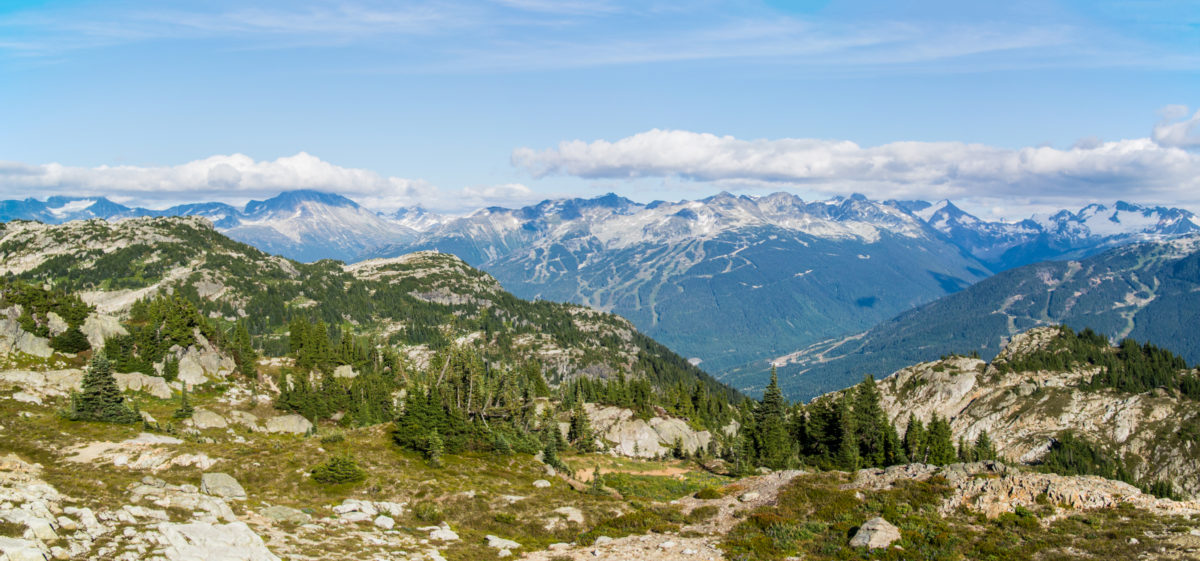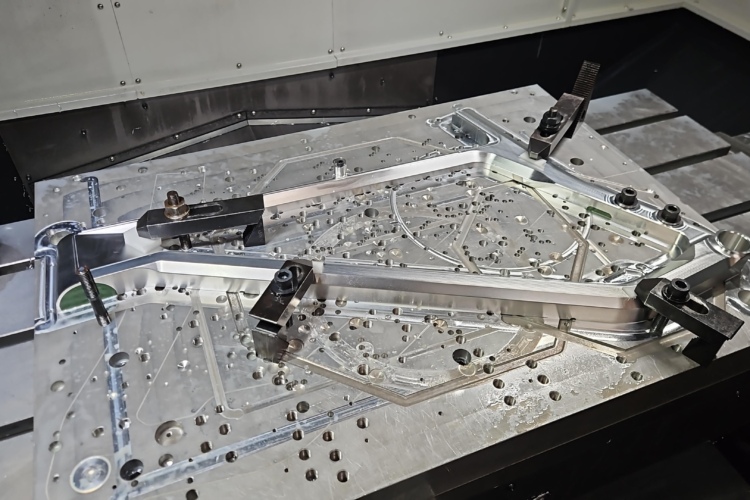
I’m crouched off the side of the Flank trail in Whistler, carefully moving individual sticks and leaves while scanning the ground.
“Shit. Shhhhhhit! Shhhhhhiiiiiiiiiiiit!!!”
I’m looking for two small, black aluminum pieces that make up part of Rocky Mountain’s Ride-9 adjustable suspension system. The bike was in the slackest position when I picked it up and when faced with a steep climb and heavy pack, I couldn’t keep the front end under control. Wasted watts and beads of sweat flew off me as I wrestled with the bars. Thirty minutes into a three-hour climb, I could take no more. I pulled over and whipped out my multi-tool with the intention of putting the Altitude in the steepest geometry setting. Just a couple of bolts. Simple, right?
[see_also id=’224186′]
Everything was going as planned until I pushed the bolt back through the eyelet of the shock. The chips on the other side weren’t quite aligned with the eyelet, causing the bolt to pop the chips out of the frame. Since I was (stupidly) doing this on the downhill side of a bench cut trail, those two pieces tumbled off into the brush. Hence all the cursing.
Miraculously, after a frantic half-hour search I found both tiny bits, reattached the shock in the new position, and recommenced climbing. Disaster averted. And let me tell you, missing out on the Lord of the Squirrels trail would indeed have been a disaster.
Into the Mystic

There’s no shuttle option for Lord of the Squirrels — you have to pay to play, and that payment takes place on Into the Mystic. Into the Mystic is a machine-built climbing trail used to get into the alpine on Mount Sproatt. The trail doesn’t even start until you’re at 3,200′ in elevation, though, so there’s plenty of climbing from the valley floor — about 1,800′ in elevation — just to access it. There are a couple different ways to get on Into the Mystic.
South of the Whistler Village in Function Junction, hop on the Rainbow-Sproatt Flank trail and climb for about two miles until you see a trail called “Don’t Look Back” on your left. After gaining over 500′ of elevation in a half-mile, Don’t Look Back intersects with Into the Mystic. Take another left and keep climbing… for a very, very long time.

I took this route from Creekside because it looked to be the most direct. What I neglected to think about was that being direct also meant it was steep as shit! The bottom of the Flank trail started off steep, and things got steeper from there. Don’t Look Back was short but brutal — I walked as much as I rode. If you’re looking to make a tough day tougher, go this way. Otherwise, see below.
The more sensible route, as well as the one closer to the Village, is to climb on pavement through the swanky Stonebridge neighborhood to a trail called Darwin’s. After a short but grueling grind on loose gravel, you’ll end up on the Flank trail north of Into the Mystic. Once you’re on this section of the Flank trail, there’s not much climbing. It’s rolling and mellow, which will give you a chance to compose yourself before the long climb on Into the Mystic.

Just because Into the Mystic is machine-built and designated as a climbing trail, don’t assume it’s a walk in the park. Sure, the trail is smooth and devoid of any technical features, but it’s a strenuous and relentless climb. Over five miles, you’ll gain 3,000′ of elevation, which equates to an average grade of 11.5%. Ouch.
Much of the climb is beneath towering hemlock, red cedar, fir, and spruce trees, so even if it’s hot, you’ll have cover from the sun. Streams and waterfalls along the climb provide an opportunity to dunk your head as you make your way up. The transition into the alpine is abrupt — one minute you’re riding in the trees and the next, you’re in a huge alpine meadow.
On the Rocks

The climbing doesn’t end once you reach the alpine, which could be considered a blessing and a curse. A blessing because the additional elevation gained affords the opportunity to soak in some of the incredible views you worked so hard to see. And a curse because, well, it’s more climbing.
On the Rocks connects Into the Mystic with Lord of the Squirrels.As the name suggests, there are rocks on the trail, but there’s nothing overly technical or challenging. It’s just over two miles in length with about 600′ of climbing, most of which is gained in the first mile. The summit of On the Rocks also serves as the highpoint of the ride, at nearly 6,000′. Stunning views of Whistler, Blackcomb, and the rest of the Coast Mountains surround you. Catch your breath, grab a snack, and put your knee pads on — you’re about to go down.
On the Rocks descends for about a mile, winding around alpine lakes, before you get to Lord of the Squirrels.
Lord of the Squirrels

Once On the Rocks meets Lord of the Squirrels, you’re nearly out of the alpine, but the descending is just beginning. The raw, hand-cut trail is the exact opposite of Into the Mystic. It’s classified as a blue trail — and it certainly is by Whistler’s standards — but there are plenty of rock rolls, roots, and tight switchbacks to keep you on your toes. Sight lines are excellent, though, and once you start to get into the rhythm of the trail, confidence increases and your brakes open up. Stay focused, but trust that the trail builders aren’t going to run you into anything too sketchy.
Lord of the Squirrels isn’t a flow trail by any means, but like any good trail it does have its own unique flow. I rode it in late summer after a long dry spell and a season full of riders, so it was pretty rough. Not bike park rough, mind you, but there were plenty of dusty bomb holes and braking bumps. By picking creative lines I was able to hop over lots of these sections, though. Dips and rises in the trail provide ample opportunity for small doubles as well.

I stopped once on a granite outcropping to take a couple photos of the Black Tusk, but otherwise I pinned it down the length of Lord of the Squirrels. It’s a raucous, rowdy romp, dropping 3,000′ over four miles back to the Flank trail. Upon reaching the Flank, there’s another 1,000′ of elevation to lose to get back to the valley floor. This can be achieved on any number of trails ranging from flowy blue lines to black, double black, and pro-only options.
Whistler is home to tougher, more challenging, much more technical trails — no doubt — but for sheer fun factor, Lord of the Squirrels has to be near the top.
History

Obviously, mountain bike trails don’t build themselves. It’s thanks to local trail organizations, dedicated builders, volunteers, and donations that we’re fortunate enough to have trails like Lord of the Squirrels to ride. I reached out to the Whistler Off Road Cycling Association (WORCA) to get some insight into how the project came about. Jerome David, WORCA’s VP, was kind enough to respond.
As expected for a project of this magnitude, the planning started a long time ago. By Jerome’s account, initial discussions first took place seven years back. The Resort Municipality of Whistler (RMOW) organized the Trail Planning Working Group (TPWG) to bring together all the stakeholders involved. What might be unexpected — at least to builders in the US — was the ease of the approval process. Jerome repeatedly pointed out how quickly everyone got on board.
People were already exploring the area on their own, even without a trail. Instead of cracking down, the relevant stakeholders decided to come up with a solution. Whistler’s economy is entirely dependent on tourism, and the customer base (namely, mountain bikers) wanted to ride into the alpine under their own power.
“A pressing need to manage the area in question arose as more people wandered that way,” Jerome explained. “The approval process was not intense. We were lucky the need for trail growth was recognized. So it happened rather quickly. Again, I quite want to emphasize, we were lucky to have an easy planning authorization process for this project.”
The process really got underway around 2013 when WORCA hired Dan Raymond as the lead for the hand-cut Lord of the Squirrels descent. Jerome had flagged a route down, but left the building to Dan while he focused on fundraising efforts. Meanwhile, RMOW crews handled the construction of Into the Mystic, and Spencer Charlton of Alpine Works LTD built On the Rocks. The build was intense. Alpine Works used a mini excavator and mini dump trucks to move all the rocks. WORCA’s crews had alternating schedules: four days on, camping in the alpine, and four days off.
In all, the municipality spent $1,200,000 CAD, while WORCA spent $202,000 CAD, not including the 32,000 hours of volunteer labor. WORCA’s funds came from locals, the American Friends of Whistler, the National Trail Coalition, and local government. Jerome estimates maintenance costs will run around $5,000-7,000 per year for the first 2-3 years, gradually decreasing as the trail settles in.
“WORCA is proud the Lord of the Squirrels descent came in under budget, on time, and built to local trail standards.” -Jerome David, WORCA VP
The alpine project isn’t complete by any means. In fact, Phase 2 is already underway. Eventually, trails will span from Callaghan Valley Olympic Park to Beverly Lake, and another descent from the summit of Sproatt is in the works. They’re also discussing ways to improve the trails lower down the mountain and add more infrastructure, like parking and restrooms. For now, though, just managing Lord of the Squirrels is keeping WORCA busy.
Know Before You Go

Want to take on Lord of the Squirrels? Here are a few tips:
- Plan for an all-day adventure: I got a very late start and then had my little mishap, so I had to hustle, but you shouldn’t. Start early, take your time, and really enjoy the scenery in the alpine. Even at a steady pace with minimal breaks, it’s a five-hour ride.
- Bring plenty of food and water: See above.
- Respect the alpine environment: The ecosystem up there is fragile. Stay on the designated trail, and avoid riding the trail if it’s wet.
- Bring your nicest camera: If you’ve got something better than your smartphone camera, take it with you. Seriously, the scenery is incredible.
- What bike to ride: There’s nothing too crazy on the descent — a skilled rider could slay it on a hardtail — but a full-squish with 120-150mm of travel is ideal. A super slack enduro bike would test your patience on the climb and isn’t required for the descent.
- When to ride: Sitting at a fairly high elevation, summer is prime riding time. There were still a couple random patches of snow in the shade when I rode in late August.
- Extra credit: There are a couple opportunities to spend a little more time riding in the alpine. One trail is called With a Twist, the other is Happy Hour. Both are about two miles in length (one way) and both are out and backs. Happy Hour takes you to the summit of Mount Sproatt.









0 Comments